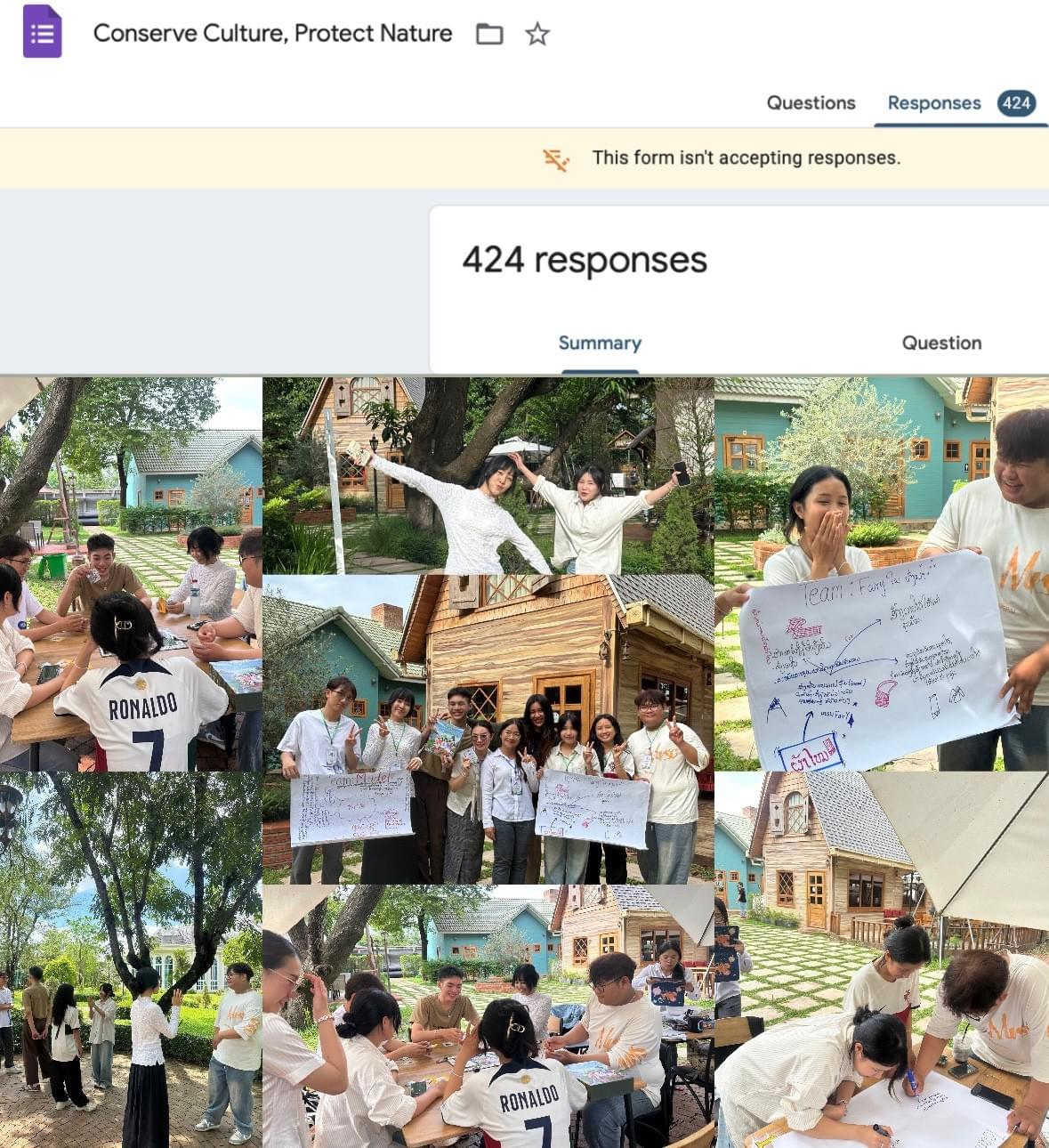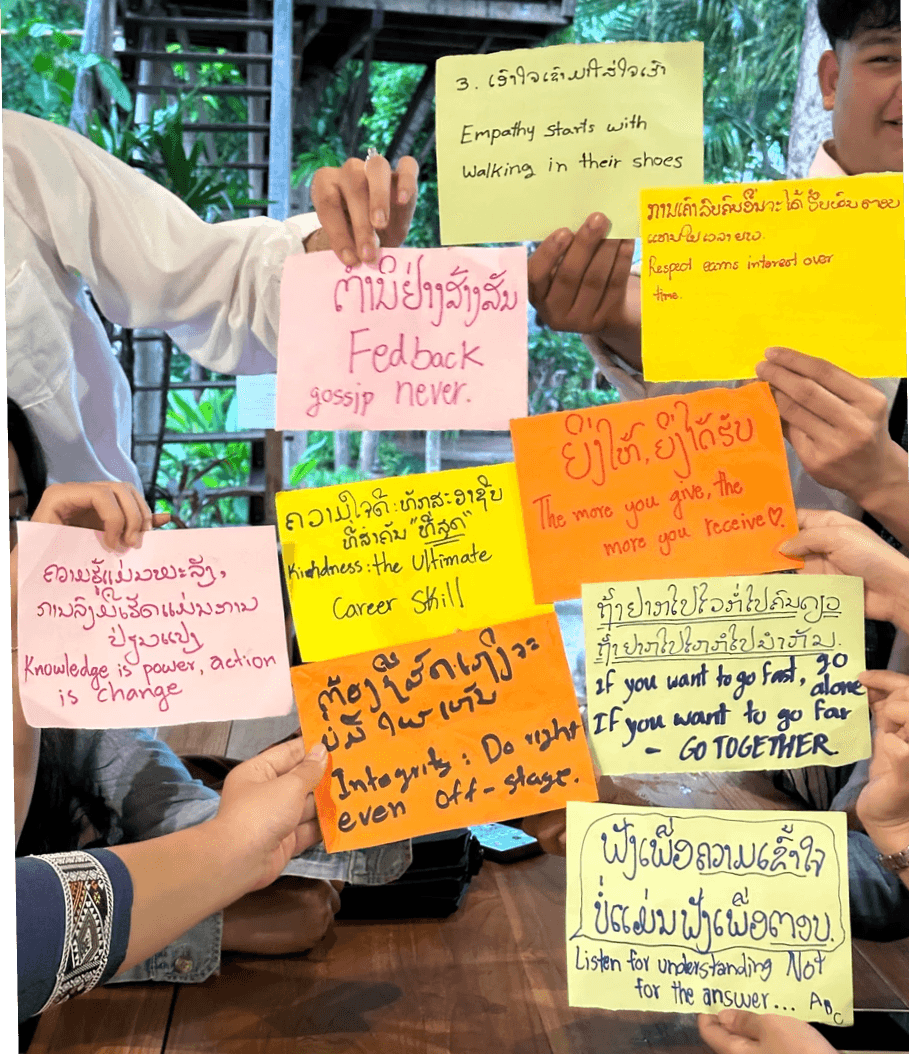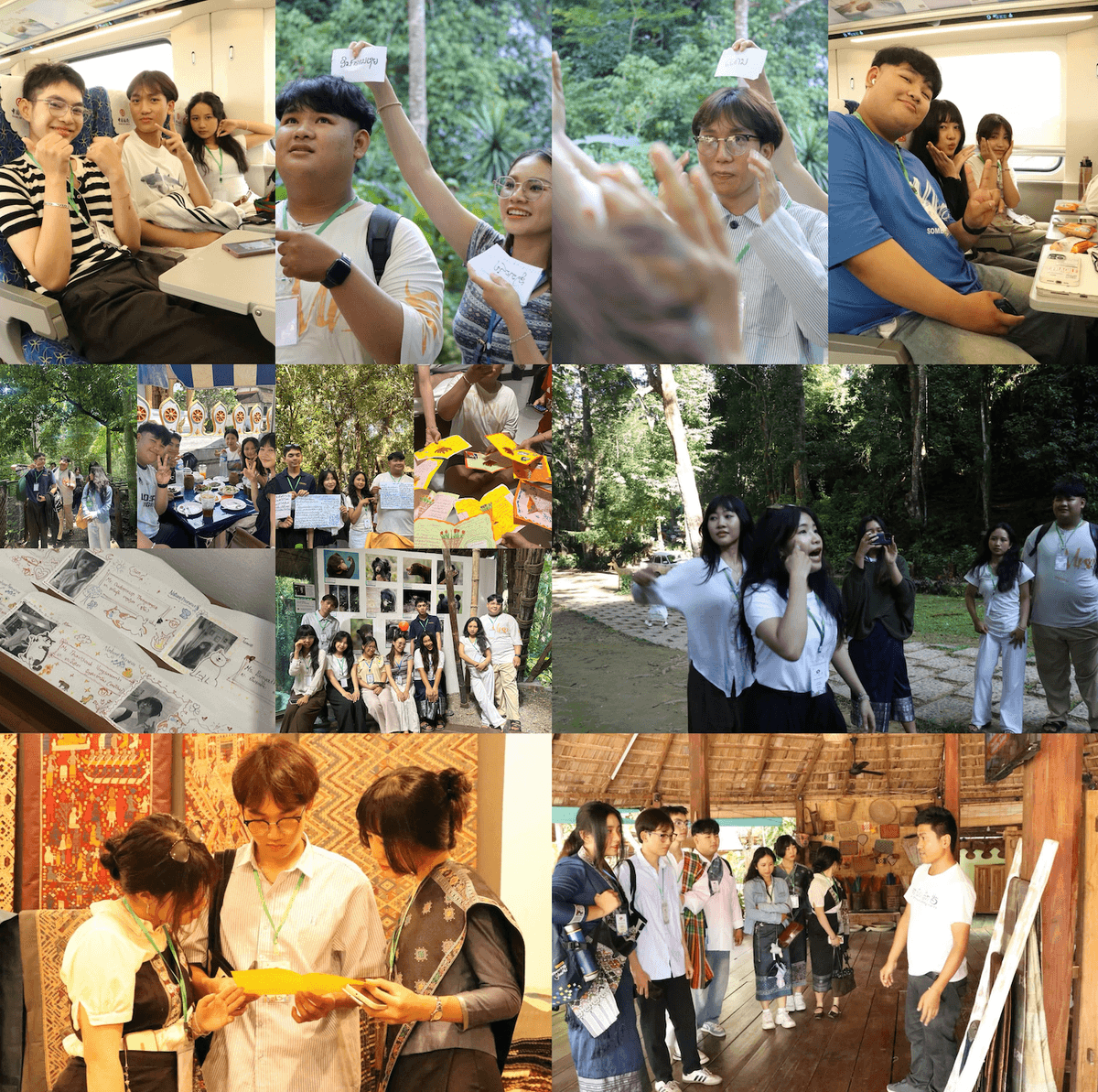Conserve Culture, Protect Nature: Empowering Lao Youth Through Innovation and Empathy
During the 11th Youth Leadership Workshop in New Delhi, India, our founder stood before representatives of UNESCO MGIEP and presented a simple yet deeply thought-provoking question:
What would happen if we brought culture and nature conservation together as a driving force to address poverty, advance sustainable development, and protect natural resources — by investing in Lao youth?
That single question became the spark that ignited our project, “Conserve Culture, Protect Nature.” With the support of a small experimental grant from UNESCO MGIEP, we set out to turn this vision into reality — blending education, leadership, innovation, and empathy to empower the next generation of young leaders in Laos.

Turning a Vision into Action
The journey began with an open call for participants, which received more than 424 applications from Vientiane Capital City. After an intensive selection process that included written applications and interviews, we carefully chose six outstanding participants who demonstrated creativity, leadership potential, and a genuine passion for conservation. Together with our three team leaders, we formed a dynamic and diverse group of nine individuals — all united by one shared mission: to bridge the gap between culture and nature in the pursuit of sustainable development.
Our first step was to launch an orientation session in Vientiane Capital City, designed to lay the foundation for learning, reflection, and collaboration. The session combined short, easy-to-understand presentations on conservation, systems thinking, and design thinking through entrepreneurship and innovation with a variety of interactive and hands-on activities.

But we wanted this to be different from a traditional classroom experience. Instead of simply telling participants what sustainability means, we wanted them to feel it, discuss it, and practice it through teamwork and creative exploration. So, we designed the program to be immersive — filled with games, brainstorming exercises, and team challenges that encouraged everyone to think critically and empathetically.
Through these activities, participants learned how seemingly separate issues — like poverty, education, culture, and the environment — are interconnected. They discovered that protecting nature also means protecting livelihoods and cultural identity. They began to see themselves not just as learners, but as potential changemakers capable of shaping solutions that work for both people and the planet.

Journey to Luang Prabang: Learning Through Experience
After the orientation, our group embarked on a journey from the bustling capital to the serene UNESCO World Heritage city of Luang Prabang. There, we focused on the central theme:
“How can poverty reduction be integrated with nature and cultural conservation?”
Our time in Luang Prabang was more than just a workshop—it was a living classroom. Every day, we learned through experiences, reflections, and interactions with local communities. Our teaching was entirely activity-based, rooted in teamwork, empathy, and togetherness.
To guide us, we carried nine SEL principles, or what we called our “nine rules,” which became the moral compass of our journey:
- Kindness: the most important professional skill 🌟
- Criticize constructively, don’t gossip 🚫💬
- Pay attention to others ❤️
- Respecting others pays off in the long run 💼💡
- If you want to go fast, go alone; if you want to go far, go together ✅
- The more you give, the more you get 💖📈
- Be honest and sincere: Do right even off-stage
- Listen to understand, not just to respond 👂🗣️
- Knowledge is power, action is change 📘⚡
Each principle carried a simple truth that shaped how we worked, learned, and lived together. Everyone was different—different ages, backgrounds, and perspectives—but these rules helped us stay united. They reminded us to treat one another like family, manage conflict with compassion, and support each other through every challenge.
By embodying these principles, we created a space filled with trust, laughter, and purpose. Every shared meal, group walk, and reflection session became an opportunity to practice what we believed: that empathy and emotional intelligence are as essential to leadership as technical skills or knowledge.

Transformation Through Connection
As the program unfolded, something extraordinary happened. The participants, who had never met before, became inseparable friends. They celebrated each other’s ideas, encouraged one another to speak up, and learned to see leadership not as competition but as cooperation.
Through field visits and discussions, they explored how local traditions, crafts, and community knowledge could play a vital role in reducing poverty while preserving both culture and biodiversity. In villages and temples, they witnessed how people live in harmony with nature and how culture itself can be a tool for conservation.
Every evening, we gathered for reflection sessions. Participants shared their experiences, emotions, and lessons learned that day. Some spoke about feeling inspired by the resilience of local communities; others shared how the trip opened their eyes to the importance of protecting Laos’s cultural heritage as part of its environmental identity.

Lasting Impact and Lifelong Lessons
When the program concluded, participants described it as life-changing. Many said they had gained a clearer vision of how they wanted to contribute to society. Some aspired to become eco-entrepreneurs integrating systems thinking into their work; others wanted to pursue community-based conservation or education projects that help both people and nature thrive.
They also reflected on the importance of Social and Emotional Learning (SEL) in leadership—how understanding one’s own emotions, listening to others, and acting with compassion can make real change possible.
The post-program survey revealed unanimous agreement: the project had not only deepened participants’ understanding of sustainability but also strengthened their confidence, emotional intelligence, and teamwork skills.

A Family Beyond the Program
Even after returning home, the six participants and three team leaders remained close. They continued to support one another’s initiatives, exchange ideas, and volunteer together. This enduring connection showed that true learning is not a one-time event but a lifelong relationship built on shared values.
For us as team leaders, this project reaffirmed that when we infuse emotion, empathy, and love into what we do—just as SEL teaches—we can inspire transformation that lasts. It’s not about how much information we share, but how deeply we connect hearts and minds to a common purpose.

Looking Forward
The success of Conserve Culture, Protect Nature is just the beginning. Our next goal is to expand this model—bringing SEL-infused conservation education to more schools, youth groups, and communities across Laos. We dream of building a network of young eco-leaders who can design creative solutions that integrate culture, nature, and sustainable livelihoods.
Through collaboration, innovation, and empathy, we believe Lao youth can lead the way in creating a future where economic growth and environmental stewardship coexist in harmony.

Conclusion
At its heart, Conserve Culture, Protect Nature is not only a youth project—it’s a philosophy. It’s about recognizing that the health of our culture and the health of our planet are inseparable. It’s about reimagining leadership as something human, kind, and inclusive.
From a single question asked in New Delhi to a transformative journey in Luang Prabang, we proved that when we invest in young people and ground our work in empathy and collaboration, the results reach far beyond what we expect.
Because when knowledge meets kindness, and action meets heart—change becomes unstoppable. 🌍💚

